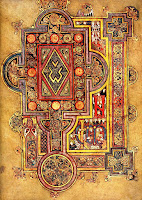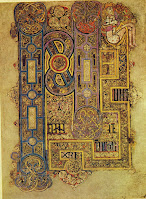St. Patricks Day 2020
The Book of Kells
As an avid thrift store shopper, I have discovered many treasures over the years. One such treasure is a scarf from Dublin, Ireland with illustrations from the Book of Kells adorning it. Doubtless it was sold in the 1970's, by the feel of the polyester material used, as a tourist item commemorating a visit to view the 8th century Book of Kells housed at the Trinity College Library, Dublin.
This unique piece of clothing found it's way promptly into my dining room, settling on a bright celtic red tablecloth and further adorned by my favourite rustic dinnerware, Midwinter's Stonehenge Creation.
Every year as a holiday approaches, I look for fresh inspiration for themes and decorations. St. Patricks Day tends to beg for green every year, and I usually grant it Ireland's signature colour. One year, I looked to the flag and an old folk song about the Troubles for a Catholic-Protestant Orange and Green theme. Another year, I leaned heavily on whites and earthy colours as I took my inspiration from rustic celtic stone crosses.
This year, the colourful illuminations of the Book of Kells provided me with the colour scheme and theme of my St. Patricks Day in quarantine.
As an avid thrift store shopper, I have discovered many treasures over the years. One such treasure is a scarf from Dublin, Ireland with illustrations from the Book of Kells adorning it. Doubtless it was sold in the 1970's, by the feel of the polyester material used, as a tourist item commemorating a visit to view the 8th century Book of Kells housed at the Trinity College Library, Dublin.
This unique piece of clothing found it's way promptly into my dining room, settling on a bright celtic red tablecloth and further adorned by my favourite rustic dinnerware, Midwinter's Stonehenge Creation.
Every year as a holiday approaches, I look for fresh inspiration for themes and decorations. St. Patricks Day tends to beg for green every year, and I usually grant it Ireland's signature colour. One year, I looked to the flag and an old folk song about the Troubles for a Catholic-Protestant Orange and Green theme. Another year, I leaned heavily on whites and earthy colours as I took my inspiration from rustic celtic stone crosses.
This year, the colourful illuminations of the Book of Kells provided me with the colour scheme and theme of my St. Patricks Day in quarantine.
The Book of Kells was written and illustrated in Saint Columba's monastery on the Scottish Isle of Iona. I remember the island well, as a group of us traveled there as Bible College students back in the winter of 2001. We took a ferry first to the Isle of Mull, stayed overnight in a hostel on the tiny village strip, and then took a second ferry to St. Rowans Bay on Iona.
 The destination was the old abbey, built around 1200AD, and
The destination was the old abbey, built around 1200AD, and
donated to the Church of Scotland in the 1800's. It was a short walk up from the ferry, located directly behind the small waterfront village. This was not the monastery of Columba, but a later Benedictine abbey that fell into disuse during the Reformation.
The beaches were beautiful white sand on an aquamarine ocean with millions of tiny seashells littering the beaches. I collected several handfulls to bring back with me. I still have them. With ruins and rolling green hillsides dotted with white sheep set against a pure blue background, it was true pristine beauty. I remember standing on the shore, wind against my face, just drinking it in.
Anyhow, that is my memory of Iona.
 Columba was exiled from his native Ireland in 563 along with twelve friends, who together founded a monastery on the Scottish island. It was in use up until it's destruction and the slaughter of all it's inhabitants in the viking raids from 794-849. It appears the current structure may have been built on the ruins of the original monastery.
Columba was exiled from his native Ireland in 563 along with twelve friends, who together founded a monastery on the Scottish island. It was in use up until it's destruction and the slaughter of all it's inhabitants in the viking raids from 794-849. It appears the current structure may have been built on the ruins of the original monastery.
 Irish monasteries of the sort founded by Columba are unique in that they were not inhabited by celebate monks, but 12 families who together formed a commune. Their main purposes were evangelism and the preservation and copying of the holy scriptures. Disciples raised up from their efforts would be sent out in groups of 12 men, along with their families, to foreign nations to start a new monastery commune and thus expand the kingdom of God.
Irish monasteries of the sort founded by Columba are unique in that they were not inhabited by celebate monks, but 12 families who together formed a commune. Their main purposes were evangelism and the preservation and copying of the holy scriptures. Disciples raised up from their efforts would be sent out in groups of 12 men, along with their families, to foreign nations to start a new monastery commune and thus expand the kingdom of God.
 These Irish monks would bring their wives and children along and together build and plant a new community usually just outside an existing city, learning the native language and engaging in trade and friendship with the local people. The monks would work tirelessly to translate and produce a copy of the Bible in the new language while maintaining their community, holding regular worship, teaching, and prayer services, and reaching out to their neighbours.
These Irish monks would bring their wives and children along and together build and plant a new community usually just outside an existing city, learning the native language and engaging in trade and friendship with the local people. The monks would work tirelessly to translate and produce a copy of the Bible in the new language while maintaining their community, holding regular worship, teaching, and prayer services, and reaching out to their neighbours.
 The destination was the old abbey, built around 1200AD, and
The destination was the old abbey, built around 1200AD, and donated to the Church of Scotland in the 1800's. It was a short walk up from the ferry, located directly behind the small waterfront village. This was not the monastery of Columba, but a later Benedictine abbey that fell into disuse during the Reformation.
I was most drawn to the old stone celtic crosses standing like ancient beacons against the sky. Of the original 360 that had been scatterd across the island, only three remain, having all but been destroyed in the Reformation. Sad.
Anyhow, that is my memory of Iona.
 Columba was exiled from his native Ireland in 563 along with twelve friends, who together founded a monastery on the Scottish island. It was in use up until it's destruction and the slaughter of all it's inhabitants in the viking raids from 794-849. It appears the current structure may have been built on the ruins of the original monastery.
Columba was exiled from his native Ireland in 563 along with twelve friends, who together founded a monastery on the Scottish island. It was in use up until it's destruction and the slaughter of all it's inhabitants in the viking raids from 794-849. It appears the current structure may have been built on the ruins of the original monastery. Irish monasteries of the sort founded by Columba are unique in that they were not inhabited by celebate monks, but 12 families who together formed a commune. Their main purposes were evangelism and the preservation and copying of the holy scriptures. Disciples raised up from their efforts would be sent out in groups of 12 men, along with their families, to foreign nations to start a new monastery commune and thus expand the kingdom of God.
Irish monasteries of the sort founded by Columba are unique in that they were not inhabited by celebate monks, but 12 families who together formed a commune. Their main purposes were evangelism and the preservation and copying of the holy scriptures. Disciples raised up from their efforts would be sent out in groups of 12 men, along with their families, to foreign nations to start a new monastery commune and thus expand the kingdom of God. These Irish monks would bring their wives and children along and together build and plant a new community usually just outside an existing city, learning the native language and engaging in trade and friendship with the local people. The monks would work tirelessly to translate and produce a copy of the Bible in the new language while maintaining their community, holding regular worship, teaching, and prayer services, and reaching out to their neighbours.
These Irish monks would bring their wives and children along and together build and plant a new community usually just outside an existing city, learning the native language and engaging in trade and friendship with the local people. The monks would work tirelessly to translate and produce a copy of the Bible in the new language while maintaining their community, holding regular worship, teaching, and prayer services, and reaching out to their neighbours. As far as missions efforts through the centuries go, I am most impressed by Columba's monastery commune model.
This St. Patricks Day, we celebrate with my sister, who is visiting from California... she found herself here amidst the first lockdowns, announced just this week. Well, no worries! We are Irish, that we are, and we intend to make merry of our Saint Patties' Day, all th' same!
This St. Patricks Day, we celebrate with my sister, who is visiting from California... she found herself here amidst the first lockdowns, announced just this week. Well, no worries! We are Irish, that we are, and we intend to make merry of our Saint Patties' Day, all th' same!
A simple affair, suited to an afternoon tea, was set in order. I spent an hour making an Irish soda apple-cheddar scone, baked in a cast iron skillet, which was accompanied by a hot pot of tea.
It was wonderfully rustic and flavourful. I used whole spelt flour, which added a nice nutty undertone and a hearty weight to the cake. It was eaten hot, with an abundance of butter, slathered on cold, one bite at a time.
It was wonderfully rustic and flavourful. I used whole spelt flour, which added a nice nutty undertone and a hearty weight to the cake. It was eaten hot, with an abundance of butter, slathered on cold, one bite at a time.
The apples and cheddar provided just the right balance of sweet and savoury, and the crust that formed in the skillet contrasted nicely with the soft, fluffy centre. Truly a medieval delight!
Recipe
Served with baked potatoes, and all the fixings, it make for a simple Irish peasant lunch. And of course, my sister brought her bubly, thoughtfully green to match the shamrock spirit!
Happy St. Patties Day!
Love, Heather [McCrary] Wathen
















Comments
Post a Comment